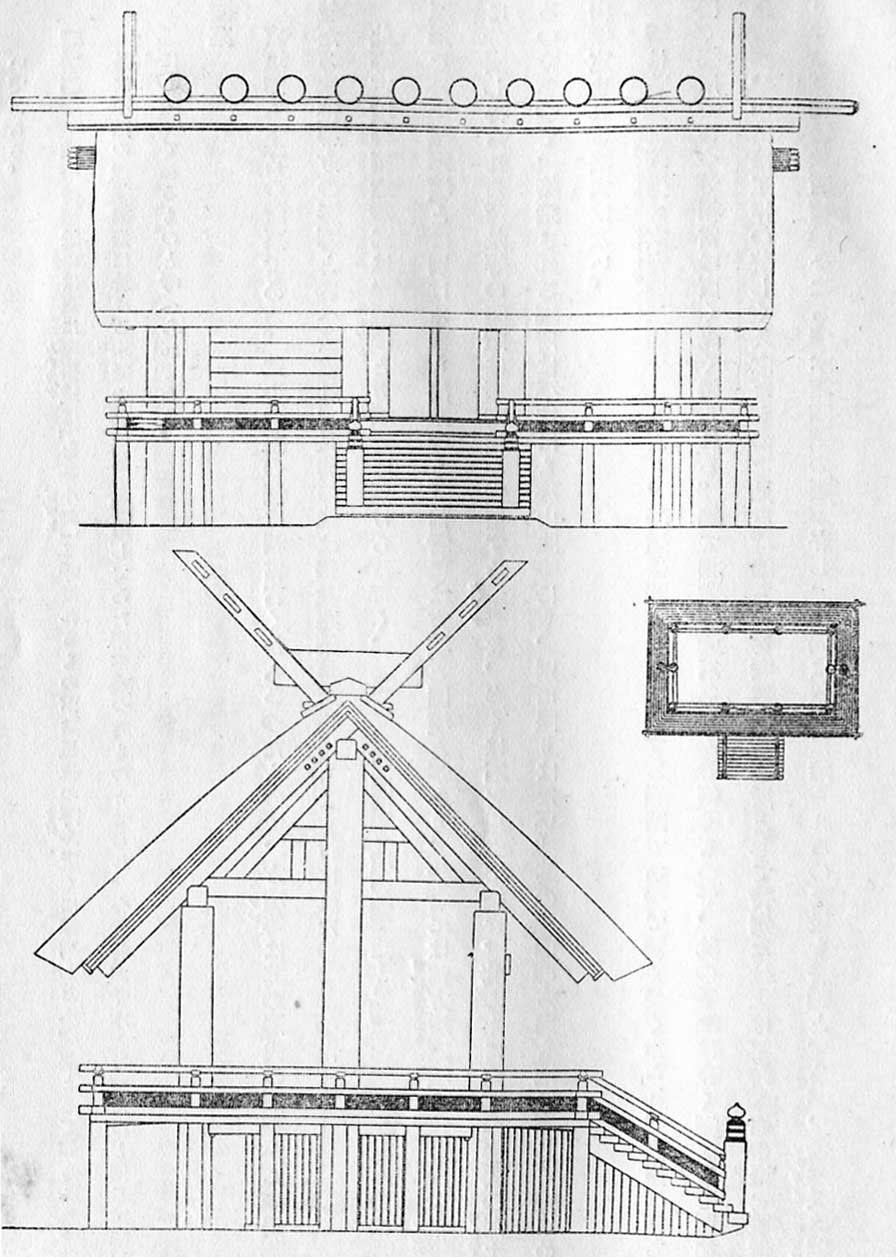shinmei-zukuri on:
[Wikipedia]
[Google]
[Amazon]
 is an ancient Japanese
is an ancient Japanese

Shinmei-zukuri
accessed on December 1, 2009
History and Typology of Shrine Architecture
Encyclopedia of Shinto accessed on November 29, 2009 *, * Traditional Japanese architecture Shinto architecture Shinmei shrines {{Shinmei shrines
 is an ancient Japanese
is an ancient Japanese architectural style
An architectural style is a classification of buildings (and nonbuilding structures) based on a set of characteristics and features, including overall appearance, arrangement of the components, method of construction, building materials used, for ...
typical of Ise Grand Shrine
The , located in Ise, Mie Prefecture of Japan, is a Shinto shrine dedicated to the solar goddess Amaterasu Ōmikami and the grain goddess Toyouke-hime (Toyouke Omikami). Also known simply as , Ise Shrine is a shrine complex composed of many Shi ...
's ''honden
In Shinto shrine architecture, the , also called , or sometimes as in Ise Shrine's case, is the most sacred building at a Shinto shrine, intended purely for the use of the enshrined ''kami'', usually symbolized by a mirror or sometimes by a sta ...
'', the holiest of Shinto shrines
A Stuart D. B. Picken, 1994. p. xxiii is a structure whose main purpose is to house ("enshrine") one or more kami, , the deities of the Shinto religion.
The Also called the . is where a shrine's patron is or are enshrined.Iwanami Japanese dic ...
.Encyclopedia of Shinto It is most common in Mie Prefecture
is a Prefectures of Japan, prefecture of Japan located in the Kansai region of Honshu. Mie Prefecture has a population of 1,781,948 () and has a geographic area of . Mie Prefecture is bordered by Gifu Prefecture to the north, Shiga Prefecture an ...
.JAANUS
History
Ancientshrines
A shrine ( "case or chest for books or papers"; Old French: ''escrin'' "box or case") is a sacred space dedicated to a specific deity, ancestor worship, ancestor, hero, martyr, saint, Daemon (mythology), daemon, or similar figure of respect, wh ...
were constructed according to the style of dwellings ( Izumo Taisha)Young & Young (2007:50)Kishida (2008:33) or storehouses (Ise Grand Shrine
The , located in Ise, Mie Prefecture of Japan, is a Shinto shrine dedicated to the solar goddess Amaterasu Ōmikami and the grain goddess Toyouke-hime (Toyouke Omikami). Also known simply as , Ise Shrine is a shrine complex composed of many Shi ...
).Fletcher and Cruickshank (1996:724) The buildings had gabled roofs, raised floors, plank walls, and were thatched with reed or covered with hinoki cypress bark. Such early shrines did not include a space for worship. Three important forms of ancient shrine architectural styles exist: '' taisha-zukuri'', ''shinmei-zukuri'', and '' sumiyoshi-zukuri''Kishida (2008:34) They are exemplified by Izumo Taisha, Nishina Shinmei Shrine and Sumiyoshi Taisha,Kishida (2008:35) respectively, and date to before 552.Kishida (2008:126) According to the tradition of '', the buildings or shrines were faithfully rebuilt at regular intervals adhering to the original design. In this manner, ancient styles have been replicated through the centuries to the present day.

Structure
This style is characterized by an extreme simplicity. Its basic features can be seen in Japanese architecture from theKofun period
The is an era in the history of Japan from about 300 to 538 AD (the date of the introduction of Buddhism), following the Yayoi period. The Kofun and the subsequent Asuka periods are sometimes collectively called the Yamato period. This period is ...
(250–538 C.E.) onwards and it is considered the pinnacle of Japanese traditional architecture. Built in plane-unfinished wood, the ''honden'' is either 3x2 ''ken'' or 1x1''ken'' in size, has a raised floor, a gabled roofA gable is the generally triangular portion of a wall enclosed between the edges of a sloping roof. with an entry on one of the non-gabled sides (), no upward curve at the eaves, and purely decorative logs called '' chigi'' (vertical) and ''katsuogi
or are short, decorative logging, logs used in Japanese architecture, Japanese and Shinto architecture. They are placed at right angles to the ridgeline of roofs, and are usually featured in religious or imperial architecture. ''Katsuogi'' pred ...
'' (horizontal) protruding from the roof's ridge.
Because shrines used to be rebuilt every 20 years, as Ise Shrine still is, shrines of this type are mostly of recent construction. The oldest extant example is Nishina Shinmei Shrine,Jinja KenchikuShogakukan
is a Japanese publisher of comics, magazines, light novels, dictionaries, literature, non-fiction, home media, and other media in Japan.
Shogakukan founded Shueisha, which also founded Hakusensha. These are three separate companies, but ...
Nihon Daihyakka Zensho, accessed on November 29, 2009 which gives the name to the style.
See also
* Austronesian architectureNotes
References
*JAANUSShinmei-zukuri
accessed on December 1, 2009
History and Typology of Shrine Architecture
Encyclopedia of Shinto accessed on November 29, 2009 *, * Traditional Japanese architecture Shinto architecture Shinmei shrines {{Shinmei shrines